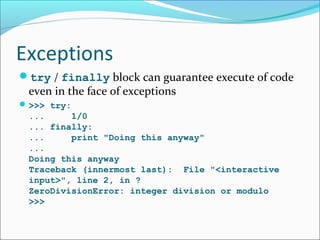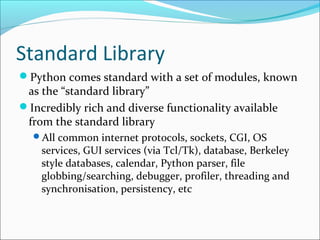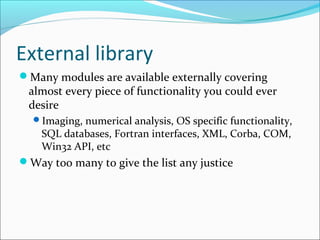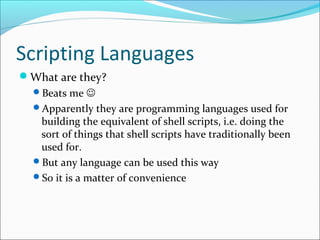Pythonintroduction
- 1. What Is Python? Created in 1990 by Guido van Rossum While at CWI, Amsterdam Now hosted by centre for national research initiatives, Reston, VA, USA Free, open source And with an amazing community Object oriented language “Everything is an object”
- 2. Why Python?Designed to be easy to learn and master Clean, clear syntax Very few keywords Highly portable Runs almost anywhere - high end servers and workstations, down to windows CE Uses machine independent byte-codes Extensible Designed to be extensible using C/C++, allowing access to many external libraries
- 3. Python: a modern hybrid A language for scripting and prototyping Balance between extensibility and powerful built-in data structures genealogy: Setl (NYU, J.Schwartz et al. 1969-1980) ABC (Amsterdam, Meertens et al. 1980-) Python (Van Rossum et all. 1996-) Very active open-source community
- 4. Prototyping Emphasis on experimental programming: Interactive (like LISP, ML, etc). Translation to bytecode (like Java) Dynamic typing (like LISP, SETL, APL) Higher-order function (LISP, ML) Garbage-collected, no ptrs (LISP, SNOBOL4)
- 5. Prototyping Emphasis on experimental programming: Uniform treatment of indexable structures (like SETL) Built-in associative structures (like SETL, SNOBOL4, Postscript) Light syntax, indentation is significant (from ABC)
- 6. Most obvious and notorious features Clean syntax plus high-level data types Leads to fast coding Uses white-space to delimit blocks Humans generally do, so why not the language? Try it, you will end up liking it Variables do not need declaration Although not a type-less language
- 7. A Digression on Block Structure There are three ways of dealing with IF structures Sequences of statements with explicit end (Algol-68, Ada, COBOL) Single statement (Algol-60, Pascal, C) Indentation (ABC, Python)
- 8. Sequence of Statements IF condition THEN stm; stm; .. ELSIF condition THEN stm; .. ELSE stm; .. END IF; next statement;
- 9. Single Statement IF condition THEN BEGIN stm; stm; END .. ELSE IF condition THEN BEGIN stm; .. END; ELSE BEGIN stm; .. END; next-statement;
- 11. Pythonwin These examples use Pythonwin Only available on Windows GUI toolkit using Tkinter available for most platforms Standard console Python available on all platforms Has interactive mode for quick testing of code Includes debugger and Python editor
- 12. Interactive Python Starting Python.exe, or any of the GUI environments present an interactive mode >>>prompt indicates start of a statement or expression If incomplete, ...prompt indicates second and subsequent lines All expression results printed back to interactive console
- 13. Variables and Types(1 of 3) Variables need no declaration >>> a=1 >>> As a variable assignment is a statement, there is no printed result >>> a 1 Variable name alone is an expression, so the result is printed
- 14. Variables and Types (2 of 3) Variables must be created before they can be used >>> b Traceback (innermost last): File "<interactive input>", line 1, in ? NameError: b >>> Python uses exceptions - more detail later
- 15. Variables and Types (3 of 3) Objects always have a type >>> a = 1 >>> type(a) <type 'int'> >>> a = "Hello" >>> type(a) <type 'string'> >>> type(1.0) <type 'float'>
- 16. Assignment versus Equality Testing Assignment performed with single = Equality testing done with double = (==) Sensible type promotions are defined Identity tested with is operator. >>> 1==1 1 >>> 1.0==1 1 >>> "1"==1 0
- 17. Simple Data Types Strings May hold any data, including embedded NULLs Declared using either single, double, or triple quotes >>> s = "Hi there" >>> s 'Hi there' >>> s = "Embedded 'quote'" >>> s "Embedded 'quote'"
- 18. Simple Data Types Triple quotes useful for multi-line strings >>> s = """ a long ... string with "quotes" or anything else""" >>> s ' a long012string with "quotes" or anything else' >>> len(s) 45
- 19. Simple Data TypesInteger objects implemented using C longs Like C, integer division returns the floor >>> 5/2 2 Float types implemented using C doubles No point in having single precision since execution overhead is large anyway
- 20. Simple Data Types Long Integers have unlimited size Limited only by available memory >>> long = 1L << 64 >>> long ** 5 21359870359209100823950217061695521146027045223 56652769947041607822219725780640550022962086936 576L
- 21. High Level Data Types Lists hold a sequence of items May hold any object Declared using square brackets >>> l = []# An empty list >>> l.append(1) >>> l.append("Hi there") >>> len(l) 2
- 22. High Level Data Types >>> l [1, 'Hi there'] >>> >>> l = ["Hi there", 1, 2] >>> l ['Hi there', 1, 2] >>> l.sort() >>> l [1, 2, 'Hi there']
- 23. High Level Data Types Tuples are similar to lists Sequence of items Key difference is they are immutable Often used in place of simple structures Automatic unpacking >>> point = 2,3 >>> x, y = point >>> x 2
- 24. High Level Data Types Tuples are particularly useful to return multiple values from a function >>> x, y = GetPoint() As Python has no concept of byref parameters, this technique is used widely
- 25. High Level Data Types Dictionaries hold key-value pairs Often called maps or hashes. Implemented using hash- tables Keys may be any immutable object, values may be any object Declared using braces >>> d={} >>> d[0] = "Hi there" >>> d["foo"] = 1
- 26. High Level Data Types Dictionaries (cont.) >>> len(d) 2 >>> d[0] 'Hi there' >>> d = {0 : "Hi there", 1 : "Hello"} >>> len(d) 2
- 27. Blocks Blocks are delimited by indentation Colon used to start a block Tabs or spaces may be used Mixing tabs and spaces works, but is discouraged >>> if 1: ... print "True" ... True >>>
- 28. Blocks Many hate this when they first see it Most Python programmers come to love it Humans use indentation when reading code to determine block structure Ever been bitten by the C code?: if (1) printf("True"); CallSomething();
- 29. Looping The for statement loops over sequences >>> for ch in "Hello": ... print ch ... H e l l o >>>
- 30. Looping Built-in function range() used to build sequences of integers >>> for i in range(3): ... print i ... 0 1 2 >>>
- 31. Looping while statement for more traditional loops >>> i = 0 >>> while i < 2: ... print i ... i = i + 1 ... 0 1 >>>
- 32. Functions Functions are defined with the def statement: >>> def foo(bar): ... return bar >>> This defines a trivial function named foo that takes a single parameter bar
- 33. Functions A function definition simply places a function object in the namespace >>> foo <function foo at fac680> >>> And the function object can obviously be called: >>> foo(3) 3 >>>
- 34. Classes Classes are defined using the class statement >>> class Foo: ... def __init__(self): ... self.member = 1 ... def GetMember(self): ... return self.member ... >>>
- 35. Classes A few things are worth pointing out in the previous example: The constructor has a special name __init__, while a destructor (not shown) uses __del__ The self parameter is the instance (ie, the this in C+ +). In Python, the self parameter is explicit (c.f. C++, where it is implicit) The name self is not required - simply a convention
- 36. Classes Like functions, a class statement simply adds a class object to the namespace >>> Foo <class __main__.Foo at 1000960> >>> Classes are instantiated using call syntax >>> f=Foo() >>> f.GetMember() 1
- 37. Modules Most of Python’s power comes from modules Modules can be implemented either in Python, or in C/C++ import statement makes a module available >>> import string >>> string.join( ["Hi", "there"] ) 'Hi there' >>>
- 38. Exceptions Python uses exceptions for errors try / except block can handle exceptions >>> try: ... 1/0 ... except ZeroDivisionError: ... print "Eeek" ... Eeek >>>
- 39. Exceptions try / finally block can guarantee execute of code even in the face of exceptions >>> try: ... 1/0 ... finally: ... print "Doing this anyway" ... Doing this anyway Traceback (innermost last): File "<interactive input>", line 2, in ? ZeroDivisionError: integer division or modulo >>>
- 40. Threads Number of ways to implement threads Highest level interface modelled after Java >>> class DemoThread(threading.Thread): ... def run(self): ... for i in range(3): ... time.sleep(3) ... print i ... >>> t = DemoThread() >>> t.start() >>> t.join() 0 1 <etc>
- 41. Standard Library Python comes standard with a set of modules, known as the “standard library” Incredibly rich and diverse functionality available from the standard library All common internet protocols, sockets, CGI, OS services, GUI services (via Tcl/Tk), database, Berkeley style databases, calendar, Python parser, file globbing/searching, debugger, profiler, threading and synchronisation, persistency, etc
- 42. External library Many modules are available externally covering almost every piece of functionality you could ever desire Imaging, numerical analysis, OS specific functionality, SQL databases, Fortran interfaces, XML, Corba, COM, Win32 API, etc Way too many to give the list any justice
- 43. Python ProgramsPython programs and modules are written as text files with traditionally a .py extension Each Python module has its own discrete namespace Name space within a Python module is a global one.
- 44. Python ProgramsPython modules and programs are differentiated only by the way they are called .py files executed directly are programs (often referred to as scripts) .py files referenced via the import statement are modules
- 45. Python Programs Thus, the same .py file can be a program/script, or a module This feature is often used to provide regression tests for modules When module is executed as a program, the regression test is executed When module is imported, test functionality is not executed
- 46. More Information on Python Can’t do Python justice in this short time frame But hopefully have given you a taste of the language Comes with extensive documentation, including tutorials and library reference Also a number of Python books available Visit www.python.org for more details Can find python tutorial and reference manual
- 47. Scripting Languages What are they? Beats me Apparently they are programming languages used for building the equivalent of shell scripts, i.e. doing the sort of things that shell scripts have traditionally been used for. But any language can be used this way So it is a matter of convenience
- 48. Characteristics of Scripting Languages Typically interpretive But that’s an implementation detail Typically have high level data structures But rich libraries can substitute for this For example, look at GNAT.Spitbol Powerful flexible string handling Typically have rich libraries But any language can meet this requirement
- 49. Is Python A Scripting Language? Usually thought of as one But this is mainly a marketing issue People think of scripting languages as being easy to learn, and useful. But Python is a well worked out coherent dynamic programming language And there is no reason not to use it for a wide range of applications.
Editor's Notes
- #2: Newsgroup comp.lang.python, with a mailing list mirror available at www.python.org Available on almost every OS in any sort of common use - all Unixs and variants, Redhat linux includes RPMs, mainframes, CE devices, etc No separate compilation step - compiled version is cached when used.
- #24: Many people new to Python have trouble seeing any significant different between tuples and lists. Lists are mutable, so can not be used as dictionary keys Tuples are immutable, so are suited to be used in the place of structures. Lists are generally used to hold variable length sequences - as tuples are immutable, they are generally used to hold sequences whose length is known in advance.
- #30: Note
- #34: The number printed in the function object representation is simply the address is memory of the object. Objects can define their own printed representation.





















![High Level Data Types
Lists hold a sequence of items
May hold any object
Declared using square brackets
>>> l = []# An empty list
>>> l.append(1)
>>> l.append("Hi there")
>>> len(l)
2](https://image.slidesharecdn.com/pythonintroduction-160304124841/85/Pythonintroduction-21-320.jpg)
![High Level Data Types
>>> l
[1, 'Hi there']
>>>
>>> l = ["Hi there", 1, 2]
>>> l
['Hi there', 1, 2]
>>> l.sort()
>>> l
[1, 2, 'Hi there']](https://image.slidesharecdn.com/pythonintroduction-160304124841/85/Pythonintroduction-22-320.jpg)


![High Level Data Types
Dictionaries hold key-value pairs
Often called maps or hashes. Implemented using hash-
tables
Keys may be any immutable object, values may be any
object
Declared using braces
>>> d={}
>>> d[0] = "Hi there"
>>> d["foo"] = 1](https://image.slidesharecdn.com/pythonintroduction-160304124841/85/Pythonintroduction-25-320.jpg)
![High Level Data Types
Dictionaries (cont.)
>>> len(d)
2
>>> d[0]
'Hi there'
>>> d = {0 : "Hi there", 1 :
"Hello"}
>>> len(d)
2](https://image.slidesharecdn.com/pythonintroduction-160304124841/85/Pythonintroduction-26-320.jpg)


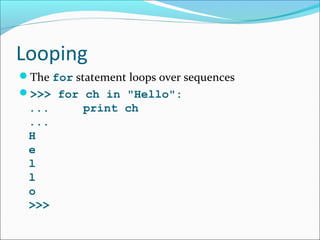







![Modules
Most of Python’s power comes from modules
Modules can be implemented either in Python, or in
C/C++
import statement makes a module available
>>> import string
>>> string.join( ["Hi", "there"] )
'Hi there'
>>>](https://image.slidesharecdn.com/pythonintroduction-160304124841/85/Pythonintroduction-37-320.jpg)

